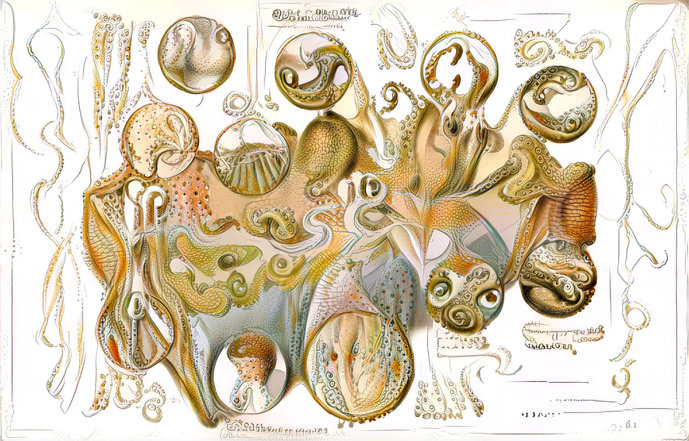

© Michail Rybakov
The project sketches presented by Professor Dr. Bruno Latour in the May (2018) sitting of the seminar “Critical Zones” were as inspiring as they were varied, ranging from research on exhibition formats for theoretical and historical contributions to artworks. The work by Michail Rybakov, an alumni of the media art department at HfG Karlsruhe, belongs to the latter category. It is just one of many ideas that were suggested in the seminar. The work starts with Ernst Haeckel’s (1834–1919) taxonomical classification panels, who defined the modern term of ecology in 1866 as “the comprehensive science of the relations of the organism to the surrounding outside world.”
Rybakov edited these panels, not with the help of the artist’s genius and his imagination, but through the technical “imagination” of neural networks, image processing by artificial intelligence. Using neural-style-transfer-algorithms, a program was fed with Haeckl panels and trained to recognize visual patterns. Haeckl’s extracted illustrative style was projected in a sectional diagram normally used for geosciences and used often in the seminar. This resulted in image worlds that were strangely familiar, and yet fascinatingly alien. They show bizarre landscapes of biological material folding into one another, like living worlds that generate their own environment such as the merging of living organisms with their ecology. Rybakov says of his own work:
"We are conditioned to look for meaning in scientific illustrations. While the meaning is lost through the process of neural style transfer, the illustration gains a lot of visual complexity. As viewers we may sense a deep cross-interlocking between the animal and its environment, but we do not get the chance to actually understand the specifics of their relationships." (rybakov.com/blog/visualizing_complexity)
Tutors: Daniel Irrgang, Prof. Bruno Latour